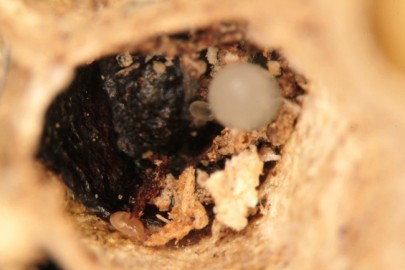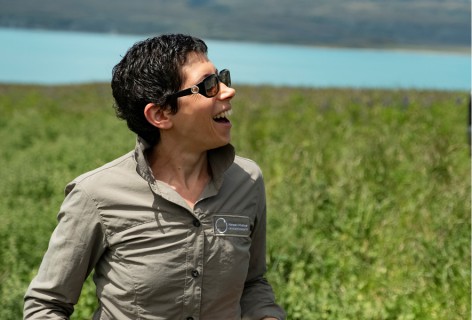Wasp biocontrol update 3
In this section
The first year of the wasp biocontrol programme is drawing to a close and it is time to reflect on the challenges and success to date.

Immature mites in the nests alongside adult mites in cells containing wasp eggs or larvae. Image: Bob Brown
Greetings everyone,
The first year of the wasp biocontrol programme is drawing to a close and it is time to reflect on the challenges and success to date.
At the very start of the year we stroke success with answers to two important questions: Yes, the mite is naturally found outside Canterbury – where it was discovered; and yes, the mite is found in wild nests of both wasp species – common and German. Refer to our first update to read a bit more about these findings.
We then tackled the issues around the legal status of the mite as a new or non-new organism. If the mite was considered a new organism, this could have caused us problems down the line. But the case we made to the Environmental Protection Authority was convincing and the mite was declared a non- new organisms. For more details refer to Update 2.
In the past few months the focus of the programme went into systematic surveys for mite prevalence and into learning how to manage and handle wasp and mites in captivity. Bob managed to dig 20 nests: 9 from Canterbury 4 from around Nelson, 4 from Nelson Lakes National Park, and 3 from Tasman region. Nests were mainly of common wasps: 17 of them, with only 3 of German wasp. A huge thank-you to those who located nests directed Bob to them, and assisted in retrieving the nests. The stings you suffered are well appreciated!
An interesting preliminary observation from the survey is a correlation between mite presence/absence, nest size (20-30% smaller when mites are present) and wasp aggressiveness (reduced when mites are present). Importantly, the survey confirmed that immature life-stages of the mite are present inside wasp nests, in cells containing wasp eggs or larvae, alongside adult mites. Why is this important? Prior to this finding we could not demonstrably say that the mites were spending a significant part of their life history inside the nest. With the finding of immature stages inside brood cells, we have gained stronger evidence that the link between the mites and the wasps is strong and not merely coincidental. While we are still a long way away from determining that the mites have a detrimental effect on wasps, we are a heck of a lot closer!
Rearing mites and wasps in captivity has been a cause for much frustration so far. The good news is that Bob found a way to extract live mites from nests, so we may be able to get away without having to mass rear wasps in order to have a supply of mites. We may still need to rear these organisms for some of the programme, so we will keep trying new protocols.
Many of you will have heard about the wasp economics report that was released in April. If you haven’t had a chance to download it – here is the link. This report was commissioned by DOC and MPI, and was written by Sapere Research Group.
Finally, winter has well and truly set, and at this time of year, when wasps are INACTIVE, we are asking for your help! Wasp queens are now hibernating in your wood-piles, behind your curtains, and in various other dry and sheltered accessible sites. We would LOVE it if you could collect wasp queens you come across, and send them our way, preferably still alive. We will examine them for presence of mites.
Instructions for sending hibernating queens:
- Keep refrigerated (NOT frozen) until posting.
- Place queen/s in a small container with some tissue paper.
- Include information about the geographic location of where the specimens were collected (a GPS reference would be fantastic, but even an address or other location identifiers would be helpful).
- Avoid sending specimens late in the week (Thursday-Friday). Even if they left your fridge alive, they are likely to reach us in an unhelpful mouldy mush form.
Address for sending:
Bob Brown
Landcare Research
PO Box 69040
Lincoln 7640
Or, for currier:
Bob Brown
Landcare Research
Fleming Reception
Gerald Street
Lincoln, 7608
Canterbury
Ph: 03 – 321 9605


